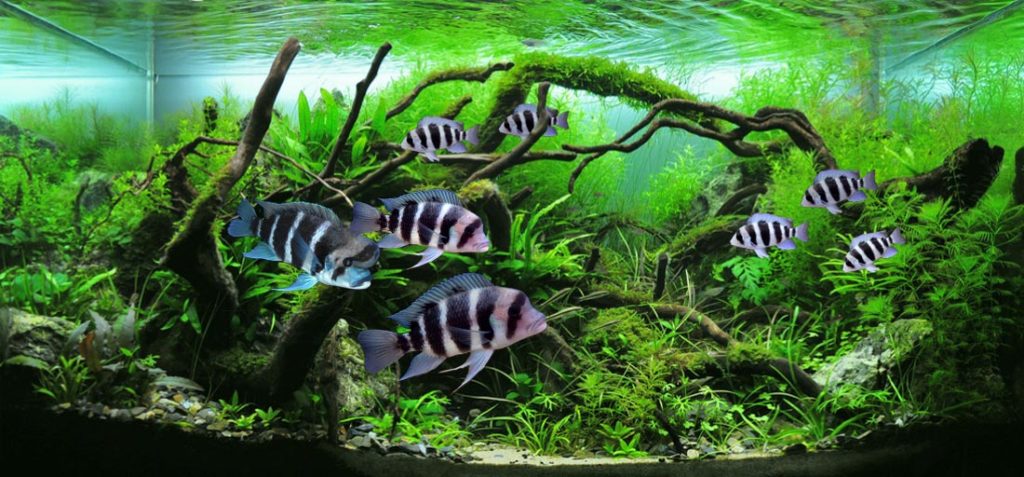Decades ago, when working for The Cichlid Factory, John Baker had a 200-gallon plywood aquarium, one of the largest in the fishroom. This aquarium was painted black on all sides, and it held a large colony of the 7-Stripe, AKA Kigoma variant of Cyphotilapia frontosa. This, along with the sibling species C. gibberosa, are both popular predatory cichlids from Lake Tanganyika.
Being benthopelagic fish found in areas of scattered bolders and open substrates, Frontosa are generally thought of as a deepwater species (depending on the source, reports range from 6 to over 120 meters of depth). Accordingly, the broodstock tank at The Cichlid Factory had a sandy bottom and was dimly lit, and the black, white, and blue coloration of the fish highly contrasted with the extremely minimalist decor. I’ve seen Frontosa kept many ways over the years, but for my tastes, nothing has surpassed putting this species on a clean black background with a natural setting.
Recently, my 6-year-old son Ethan happened to look at my laptop and was immediately drawn to a photo of a Mpimbwe Blue Frontosa on the screen. It apparently reminded him of a Pokémon card character, Barboach (which is actually definitely a Loach species; I might have to write about that some other time!). Not one to squelch any interest my kids show in fish, this led to more Internet searching: we’re off looking at videos, discussing the sexual dimorphsim of the species (including elongated fins and the massive cephalic hump that has earned this species an alternate common name of Humphead Cichlid) in terms that a 1st grader understands. We talk about a big (and currently empty) display tank upstairs, and discuss how it could hold a nice group of Frontosa.
Barren Biotope
For example, I show him the following tank from Surgikim; it’s a showstopper in my book. It fits my tastes for how I would have suggested Frontosa be displayed, featuring an open substrate and boulders, typical for the described natural habitat of the Frontosa. It is definitely what I’d try to emulate were I to create a Frontosa display.
But then, as I looked through the YouTube search results, things got strange…
…and worlds collided.
Plants with Humpheads?
Now I should note that these are certainly not representatives of the high-art Nature Aquarium or similar planted tanks, but rather are examples of what you can easily accomplish with hardy, tolerant plants. The first planted tank example from Frank Mueller makes use of standard plant species commonly recommended for low light tanks and tanks with higher pH or hardness; Java Moss, Java Ferns, and Anubias have fully overtaken the rockwork underneath (and I love seeing all the baby Julidichromis cavorting about).
In a video uploaded 2 years later, you’ll note that Mueller had dramatically cut back on the plants (and you’ll see the underlying rockwork much more clearly). I’m surprised that I actually prefer the more heavily planted version of Mueller’s tank; perhaps the key here is if you’re going to go in a certain direction, just go for it all the way? Cichlid-Forum.com clearly thought so, recognizing this aquarium as “Tank of the Month” back in January, 2012; visit http://www.cichlid-forum.com/tanks/displaytank.php?style=1&tank=14586 for more info on this setup.
The second example (from Izabella Kadr of AquaZone Aquarium Services in the Montréal, Canada region) utilizes other resilient species such as Hornwort and Vallisneria spp. Per Kadr’s comments in the video, the pH of the aquarium is maintained at 7.8, which she believes is well tolerated by the diverse range of inhabitants. The aquascape certainly seems to be more of a “riverine” inspired setup; the Geophagus sp. certainly look at home with the open sand bed and driftwood.
I was truly surprised to stumble across some examples Frontosa in planted environs, but hey, it just might work for you! Being predators, they’re going to leave plants alone, and they don’t have the digging habit that can exile many cichlids from any aquascaped aquarium. Given that tank decor is to some extent largely a matter of aesthetic tastes, so long as you can meet the husbandry needs of the fish, there is nothing fundamentally right or wrong here. We’d love to read your thoughts (and any other examples you might have to share) in the comments below.
Image Credits:
TOP: Envisioned mock planted aquarium with Frontosa composition by Matt Pedersen.
Component images:
Nature style aquascape, from The International Aquatic Plants Layout Contest 2012 by Duc Viet Bui – CC BY-SA 4.5
Large Male Frontosa – Cyphotilapia frontosa, on display at the Museo di Storia Naturale e del Territorio, Calci (Province Pisa), Italy, by Hectonichus – CC BY-SA 3.0
Subadult Frontosa – photographer unknown, OpenCage.info – CC BY-SA 2.5
Juvenile Frontosa – chemmi1976 – Public Domain







I love planted tanks, more than aesthetic they are a form of additional filtration. I would always have plants, even in my Tropheus tank. However the best looking fish in the videos you posted was the first one without plants. However I think that is probably more down to the variety and the lighting used. The blues are stunning.